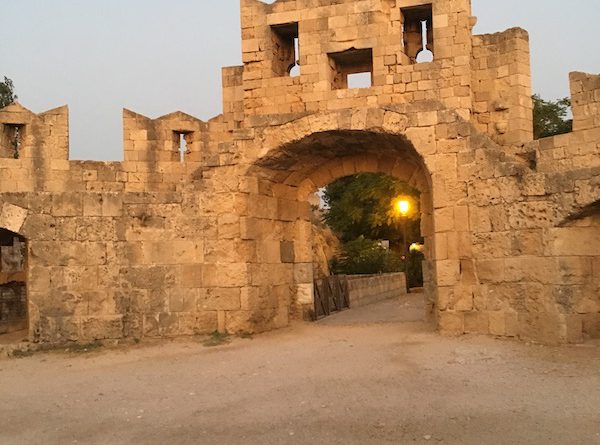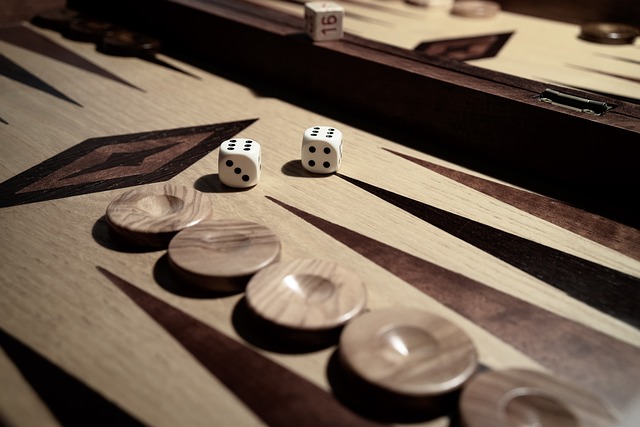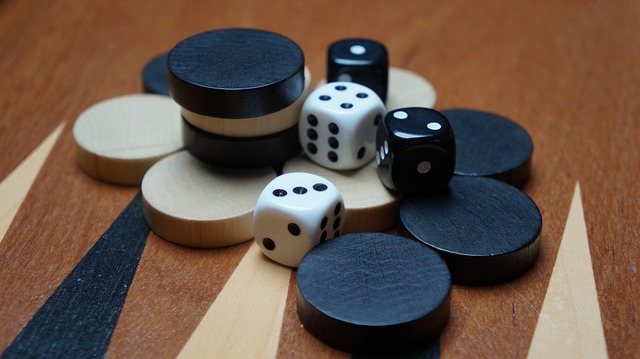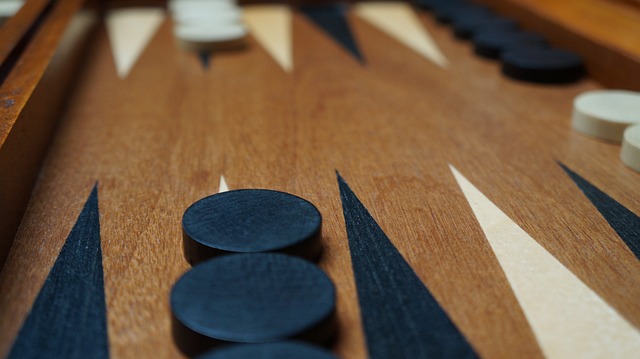
Tavli game
Introduction
Tavli game: the purpose of the game is for a player to move all of his checkers to his half of the table and then move them all out. If Tavli was an Olympic discipline, Greece would always win the Gold Medal. And it is easy to realize how true this is by sticking your nose into any Greek kafeneio where you can see men and women playing the beloved Greek game of “Tavli” while sipping a Greek coffee or a glass of ouzo with a komboloi on the table. Tavli looks a bit like the western game of backgammon. Sometimes they play very quietly, almost in a contemplative mood, sometimes the environment is very feverish and noisy. Tavli is played for fun and sometimes even for money or bet, another much loved sport by the Greeks .
“Tavli” means table in Greece . It is also the name used to indicate different games that are played on the Backgammon table.
There are three types of Tavli in Greece, commonly played:
Portes: similar to Western Backgammon
Plakoto ‘: a game where a pawn tries to trap another pawn in the same position
Fevga: game of Turkish origins where one pawn is sufficient to block a position
These games are played one after the other, in three-, five or seven-point games
Purpose of the game

tavli
Tavli game: the purpose of the game is for a player to move all of his checkers to his half of the table and then move them all out. The first player to take out all of his checkers wins the game. The starting positions are the matrix positions, called ‘mana’ in Greek. To start the game, each player throws a single die. This determines which player rolls first. If two equal numbers are rolled, then both players roll again until two different numbers are rolled. The player who rolls the highest number moves his checkers according to the numbers that are rolled on both dice. After the first roll, the players roll two dice each and take turns. The roll of the dice indicates by how many points the player must move his pieces. The pieces always move forward.
General differences between Greek and Western backgammon :
There is no doubling
Gammons and backgammons count equal (2 points)
Only one pair of dice is used and can be thrown on either side of the table. If the dice land on a pawn or do not sit properly, both must be rerolled;
At the beginning of the game, the player who starts is the one who throws the highest number. Then he rolls again and starts with these numbers (so that it is possible to start with doubles). In all subsequent rounds the winner of the last game starts the new one.
A move is completed when the opponent rolls the dice. Let’s explain better: (X against O, X throws): normally O takes the dice while X makes his moves. As long as X has a piece in his hand (or his finger on it), X can completely change his move. If X finishes his move, O can roll the dice and X’s turn is over. If 0 rolls the dice too early, he has no value and he must reroll them. This way of making moves allows for quick and simple games.
Tavli game: history
This game is one of the oldest games in existence, dating back almost 5000 years and is believed to have been developed by the ancient Egyptians. Using 15 stones, two dice, a table and a winner attitude, try to move your stones off the table before your opponent. The ancient Greeks played it too and so did the Romans. The game we know today was refined in England in the seventeenth century, a period in which it also acquired the name of Backgammon. A significant twentieth-century innovation was the addition of doubling in the 1920s. This rule was not originally part of the Tavli.
3 x 10 square game boards have been found in several archaeological sites of the ancient Egyptians. The game was known to the ancient Egyptians as the game of thirty squares or Senet (sometimes Senat). The exact rules of the game are not known. Similar tables were also found consisting of 3 x 12 squares, 3 x 6 squares and other models. It is not clear if these belonged to different games or if they were variants of the same. A number of tables finally represented Senet on one side and another popular Egyptian game, the game of twenty squares, on the other.
Backgammon like games have been played for thousands of years in all parts of the world and certainly during the Egyptian, Greek and Roman eras. The Romans left a great deal of evidence of the existence of a game they called Ludus Duodecim Scriptorum, the game of the twelve lines. This game probably derives from the Egyptian Senat which has a 3×12 point base and is played with 3 6-sided dice but, remember, the rules of the game have never been fully established.
In the first century AD, the Ludus Duodecim Scriptorum was replaced by a variant with only 2 rows of 12 points, a game that by the sixth century was called “Alea”. Both these games and others were also identified as “Tabula”, which was a generic name for board games and in the early medieval era it was usually identified with the most popular board game, the Duodecim Scriptorum/Alea /Backgammon, in the same way that the generic term “football” today normally means “soccer” in England.
In Asia, Nard’s game appeared sometime before 800 AD, in southwestern Asia or in Persia depending on which version of the story you want to believe and variations of this game are still played across the continent today. Chinese history says that “t’shu-p’u”, the Chinese name for Nard, was invented in western India, and arrived in China during the Wei dynasty (220-265 AD) and became popular from 479 to 1000 AD In Japan the game was called “Sugoroko” and was declared illegal during the reign of Empress Jito (690-697 AD). The Nard, in turn, appears to have been introduced into Europe through Italy or Spain following the Arab occupation of Sicily (902 AD).
The first mention of the game in the English press is made in the codex “Exoniensis” published in 1025: “These two shall sit at Tables…”. The “Tables” was probably brought to England by a man returning from the Crusades. Many of them in fact remained for a long time in Crete and Malta. Nard or Tables was played throughout Europe during the Middle Ages and became very popular in English inns, although chess overtook it as the most popular game in the fifteenth century. Before the end of the sixteenth century, Tables became, for some reason, a generic term for all games played on a flat surface or table.
Like many games played for money, it became unpopular with the authorities in England and, until the reign of Elizabeth I, the law prohibited the game of Tables. In the early seventeenth century, however, following some rule changes, the game underwent a revival and again invaded Europe under a variety of different names most of which have lasted to this day. Tavli and Tables are almost synonymous. It is a matter of debate whether the term backgammon is derived from the Welsh “back” (small) and “gammon” (battle) or from the Saxon “bac” (rear) “gamen” (game).
Backgammon underwent another renaissance before the First World War but vanished during the mid-twentieth century only to reappear again in the seventies and become the popular game it is today. It is also still widely played in the Middle East as “Tric-trac”. There is a whole family of Backgammon variants: Chouette (a 3 or 4 player version), team backgammon, Sixey-Acey, Dutch backgammon, Turkish backgammon (Moultezim), Greek backgammon (Tavli, Portes, Plakoto, Fevga), Gioul (from the Middle East), Acey Deucey (the Dutch version of US military backgammon), European Acey Deucey, Russian backgammon, Tabard backgammon and Icelandic backgammon (Kotra).
Tavli is a game that consists of three other different games, called “Portes” (which means “doors”, two pawns together form a “door”), “Plakoto” (comes from the Greek verb “plakono” which means to put something on top of something else, in the game a pawn is placed on top of an opponent’s pawn) and “Fevga” (from the Greek verb “Fevgo” which means “to go away” and represents the aim of the game to collect all the pawns in your home base). Portes is the equivalent of backgammon, with the exception of doubling and winning with 3 points, this is usually with 5 or 7 points. In Greece the exact equivalent of backgammon is called “Vidos”. The Greeks use to play games alternating between Portes, Plakoto and Fevga games.

Tavli game: portes
Portes is the most similar form of Tavli to Western Backgammon.
Game preparation: Game preparation is identical to that of backgammon. Each player has two pieces in the opponent’s position 1, 5 pieces in the opponent’s position 12, 3 pieces in their position 8 and 5 pieces in their position 6.
Purpose of the game: The aim of the game is to move all your pieces by moving them around the table in their own half and then to get them out gradually from the table. Whoever finishes first wins the game.
Start of the game: Each player rolls a die and the highest number begins. The starter rolls both dice to start his first turn. At the end of the whole game, the winner starts the next game.
Move: The roll of the dice indicates by how many points the player must move his pieces, applying the following rules:
A pawn can only be moved to a free position, that is, a position that is not occupied by two or more pawns.
The numbers appearing on the two dice depict two different moves. For example, if a player gets 5 and 3, he can move a checker of 5 spaces to a free position and another checker of 3 spaces, or he can move a single checker of eight spaces, but only if the intermediate spaces (both the 3 and the 5 spaces from the starting point) are free.
Doubles are played twice. For example, if a double 6 is rolled, the player has four moves of 6 to use.
Always use both numbers, or the four numbers in the case of a double.
Hitting: A pawn standing alone on a point is called a “blot”. If an opponent’s checker lands on a “spot”, the spot is eliminated and placed on the central bar that divides the table into two parts.
Re-enter the bar: When you have one or more checkers on the gauge, your obligation is to re-enter the checkers before you can start moving those still in play. To bring the pieces back in, you have to roll the dice and try to get a score that corresponds to free positions on the opponent’s half. If you are able to indent only some but not all of the tokens on the bar, the turn passes to your opponent and on the next turn you will continue to attempt to indent your tokens.
Taking Out the Checkers: Once you have managed to get all 15 of your checkers to your home plate (your positions 1-6), you can begin to take them out. You pull them out by rolling the dice and gradually removing the checkers from the positions that appear on the dice. If there is no checker on one or both of the positions that appear on the dice, you must remove the highest-ranking checkers they hold.
Scoring: The first competitor to take out all 15 pieces wins the game. If the opponent has pulled out at least one checker, he loses only one point, otherwise he loses two. There is no doubling up in this game.
Differences in rules from Backgammon:
Whoever starts playing re-rolls the dice for his first turn.
The winner buys one point for a normal win and two for a gammon. There is no backgammon. There is no doubling.
Tavli game: plakoto’
Plakoto is also played in Bulgaria where it is known as “Tapa”.
Preparation of the game: Each player starts with the 15 pawns on position 1 of the opponent. The pieces move around the table in the opposite direction, as shown in the diagram.
Purpose of the game: The aim of the game is to move all your pieces by moving them around the table in their own half and then to get them out gradually from the table. Whoever finishes first wins the game.
Start of the game: Each player rolls a die and the highest number begins. The starter rolls both dice to start his first turn. At the end of the whole game, the winner starts the next game.
Move: The roll of the dice indicates by how many points the player must move his pieces, applying the following rules:
A pawn can only be moved to a free position, that is, a position that is not occupied by two or more pawns.
The numbers appearing on the two dice depict two different moves. For example, if a player gets 5 and 3, he can move a checker of 5 spaces to a free position and another checker of 3 spaces, or he can move a single checker of eight spaces, but only if the intermediate spaces (both the 3 and the 5 spaces from the starting point) are free.
Doubles are played twice. For example, if a double 6 is rolled, the player has four moves of 6 to use.
Always use both numbers, or the four numbers in the case of a double.
Blocking the opponent: you cannot remove your opponent’s pieces from the table in this game. Instead, if your checker occupies a position occupied by another opponent’s checker alone (the stain), the opponent’s checker is trapped until you remove your checker. Two of your checkers on a position or one of your checkers on top of one of the opponent’s, creates a block that the opponent cannot modify in any way.
Locking the mother-piece: The last piece in the starting position is called the mother-piece. If this pawn is blocked by the opponent before he has left the starting position, the game ends and 2 points are lost. The only exception is if the opponent still has pawns on his starting point, since in this case his own mother-pawn is still threatened. A game in which both mother-pieces are locked is a “legate”.
Taking Out the Checkers: Once you have managed to get all 15 of your checkers to your home plate (your positions 1-6), you can begin to take them out. You pull them out by rolling the dice and gradually removing the checkers from the positions that appear on the dice. If there is no checker on one or both of the positions that appear on the dice, you must remove the highest-ranking checkers they hold.
Scoring: The first competitor to take out all 15 pieces wins the game. If the opponent has pulled out at least one checker, he loses only one point, otherwise he loses two. There is no doubling up in this game.

tavli
Tavli game: fevga
Fevga is similar to the Turkish game of “Moultezim” and the Russian game of “Narde”.
Game setup: Each player starts with the fifteen checkers on the far right point of the far side of the table, on the diagonally opposite corner from the opponent. Both players move in the same direction, clockwise, around the table.
Purpose of the game: The aim of the game is to move all your pieces by moving them around the table in their own half and then to get them out of the table as you go. White comes out in the lower right corner, red in the upper left corner.
Start of the game: Each player rolls a die and the highest number begins. The starter rolls both dice to start his first turn. At the end of the whole game, the winner starts the next game.
Move: The roll of the dice indicates by how many points the player must move his pieces, applying the following rules:
A checker can only be moved to a free position, that is, a position that is not from any of the opponent’s checkers.
The numbers appearing on the two dice depict two different moves. For example, if a player gets 5 and 3, he can move a checker of 5 spaces to a free position and another checker of 3 spaces, or he can move a single checker of eight spaces, but only if the intermediate spaces (both the 3 and the 5 spaces from the starting point) are free.
Doubles are played twice. For example, if a double 6 is rolled, the player has four moves of 6 to use.
Always use both numbers, or the four numbers in the case of a double. If only one of the numbers can be played, the higher one must be played.
First checker out: Your first checker must have passed your opponent’s starting point before you can start moving another one
There is no attack, the major difference between Fevga and other forms of Backgammon is that there is no form of attack in this game. A pawn alone controls a position and an opposing pawn cannot occupy that same position.
Limitations: It is not allowed to occupy all six positions in the starting table. If you have created a “first” (six consecutive blocked positions), and your opponent has collected all his checkers in the previous position at the beginning of your block, then you must unlock him to allow him at least one chance to move.
Taking Out the Checkers: Once you have managed to get all 15 of your checkers to the final position, you can start pulling them out. You pull them out by rolling the dice and gradually removing the checkers from the positions that appear on the dice. If there is no checker on one or both of the positions that appear on the dice, you must remove the highest-ranking checkers they hold.
Scoring: The first competitor to take out all 15 pieces wins the game and earns a point. If the opponent hasn’t pulled out a single piece, he wins two points.
